How Tight Should Climbing Shoes Fit? 7 Essential Tips (2024 Guide)
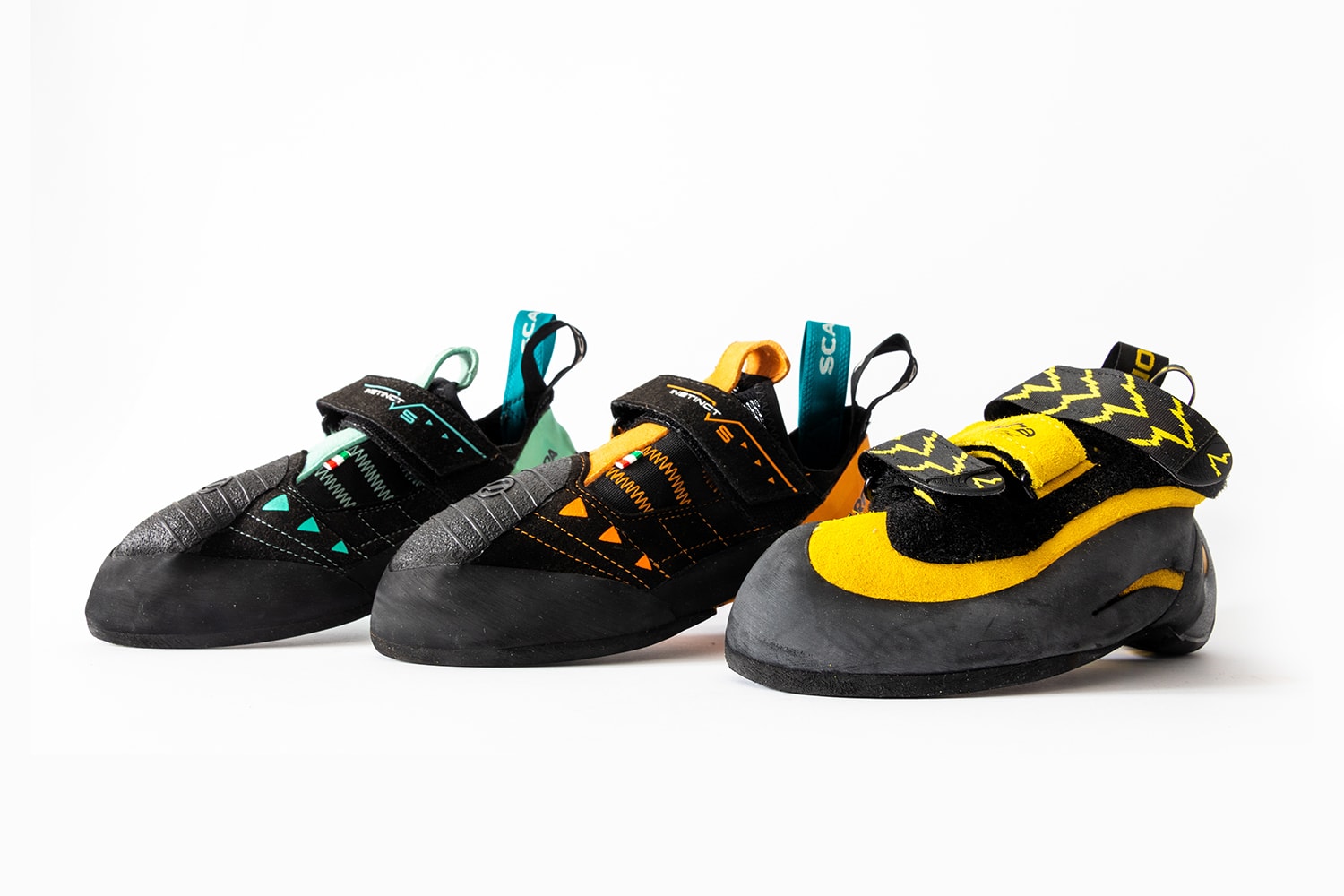
Published on: 06/14/2022
Last updated on: 05/11/2023
Today, there is an endless variety of climbing shoes to choose from. They come in all colors, shapes, and sizes and are designed and built with higher performance. With so many different shoes to choose from, it’s pretty easy to find a style you like, but it’s harder to know whether the shoe fits you. So the real question you need to ask yourself is: How should climbing shoes fit?
There are several variables to consider when understanding what makes climbing shoes fit well. This involves having knowledge of various terrain, knowing your foot shape, and considering how regularly you climb. These and other factors will affect which =shoes are right for you. Let’s explore the basic anatomy of the climbing shoe, and then I’ll explain more about how to know that you have found the perfect fit.
The Anatomy of a Climbing Shoe
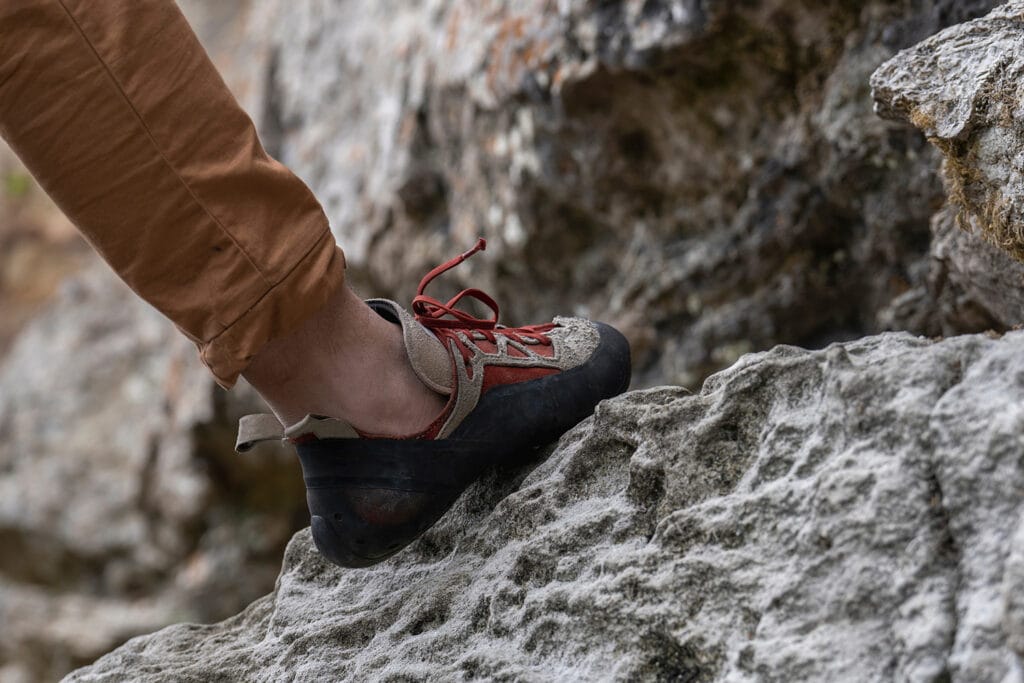
Climbing shoes are generally categorized by type. The three main types of rock shoes are neutral, moderate, and aggressive. All climbing shoes, regardless of type, have a variety of features. Important ones to note are the closure, rubber thickness, and upper, outsole, and inner lining materials. They affect the overall fit of the shoe and how they will stretch or wear over time.
Let’s go over some basic terms regarding climbing shoes.
Last
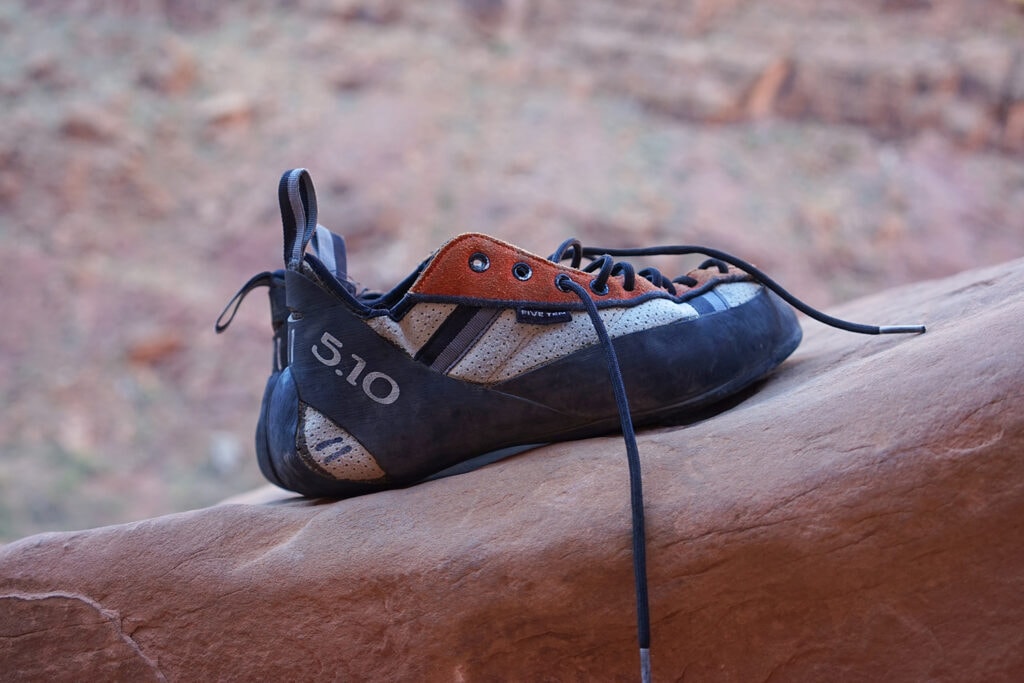
A last refers to the structure of a climbing shoe’s midsole and determines the overall shape of a rock climbing shoe. The last regulates the width, degree of downturn, and asymmetry of the shoe.
All climbing shoes are either board-lasted or slip-lasted. Slip-lasted is most common. This method involves wrapping the upper material around the foot and sewing it closed down the middle of the bottom of the foot. A slip-lasted shoe is more flexible and allows for higher sensitivity for the user. Board-lasted climbing shoes are stiffer because of an added internal structure in the midsole. These have decreased sensitivity for the user but can handle a larger amount of environments compared to slip-lasted.
Neutral vs. aggressive shoes
The last also determines the degree of downturn of a model. A traditional or flat-lasted shoe is defined as a neutral climbing shoe. Neutral shoes replicate the foot’s natural shape and are built for all-day comfort, whether you are out for overnight climbing trips, multi-pitch routes, or using them strictly for smearing on slabs.

An asymmetric last creates an asymmetric shoe. This type of last’s shape has the longest part of the shoe located over the big toe. An asymmetric last gives you a single point of contact with the rock. You’ll find this type of last in moderate and aggressive climbing shoes.
A cambered last creates the downturned shape you can see on performance shoes. This type of shoe is ideal for executing a heel hook on overhangs and generally more challenging routes. A camber lasted shoe is well suited for maximum control and performance. This last type is used most commonly by advanced climbers. Although ideal for performance, these last types are uncomfortable for long-term wear because of their unnatural shape.
Downturn
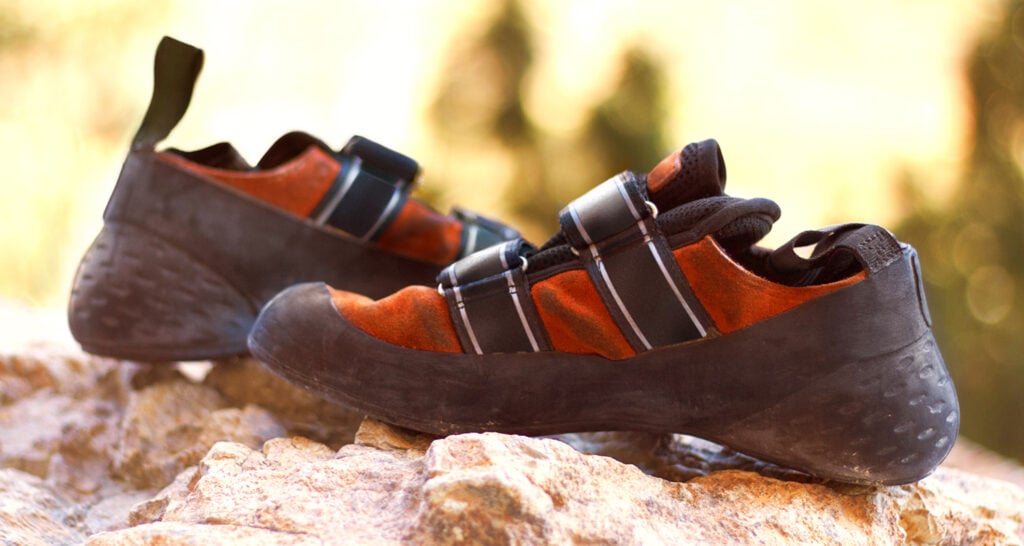
The downturn, or camber, of a climbing shoe, is meant to keep your foot rigid to create tension. This allows you to focus the most weight on your toes and is specifically helpful for grip on small holds. A cambered shoe inherently has a tighter fit. This is critical to keeping the tension and rigidity while climbing.
The sole of neutral shoes lie flat and aren’t cambered. These shoes are great for training, comfort, and all-day wear. They are designed with a stiffer midsole and thicker rubber, making them great for beginners.
Although a tight fit is critical for climbing shoes to be effective, this doesn’t mean you should be cramming your feet into your shoes. Doing so will cause long-term damage to your toes, destroy your feet, and cut off your circulation.
Toe Box
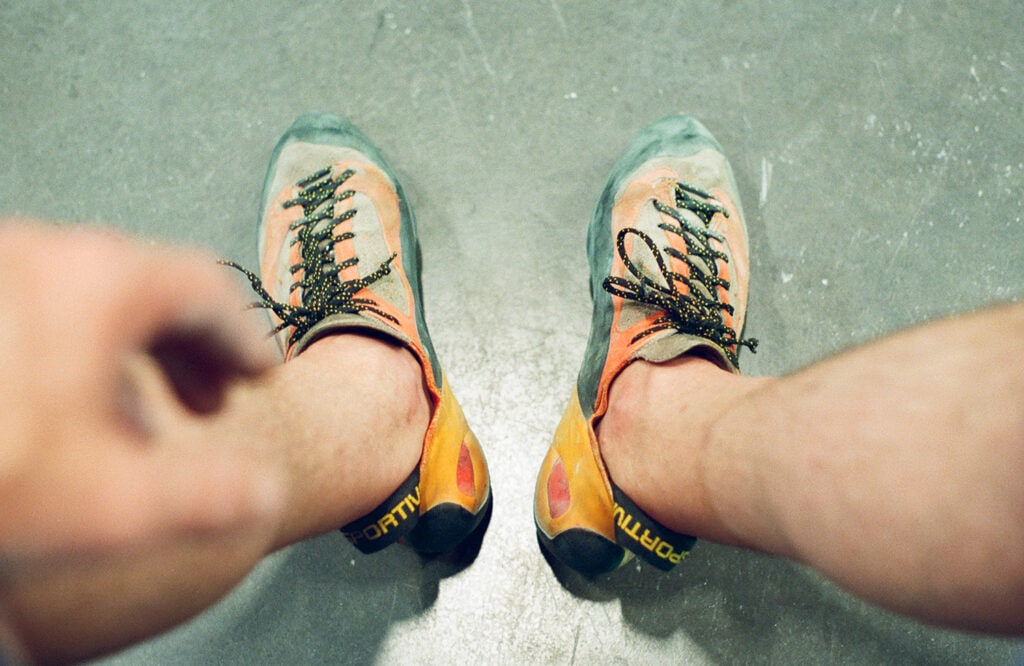
The toe box is the rounded area on a climbing shoe that surrounds the toes. This area consists of the rand, a rubber that wraps around the front of the shoe. Toe boxes come in various shapes and asymmetry, depending on the brand and design. Knowing your specific foot shape is essential when finding a toe box that fits you best.
Rand
The rand is the rubber that wraps around the sides and front of rock shoes. It acts as a protective barrier for the upper and front of the shoe, where the most wear takes place. The rand may cover a larger area than normal on more specialized shoes made for toe hooking.
Upper
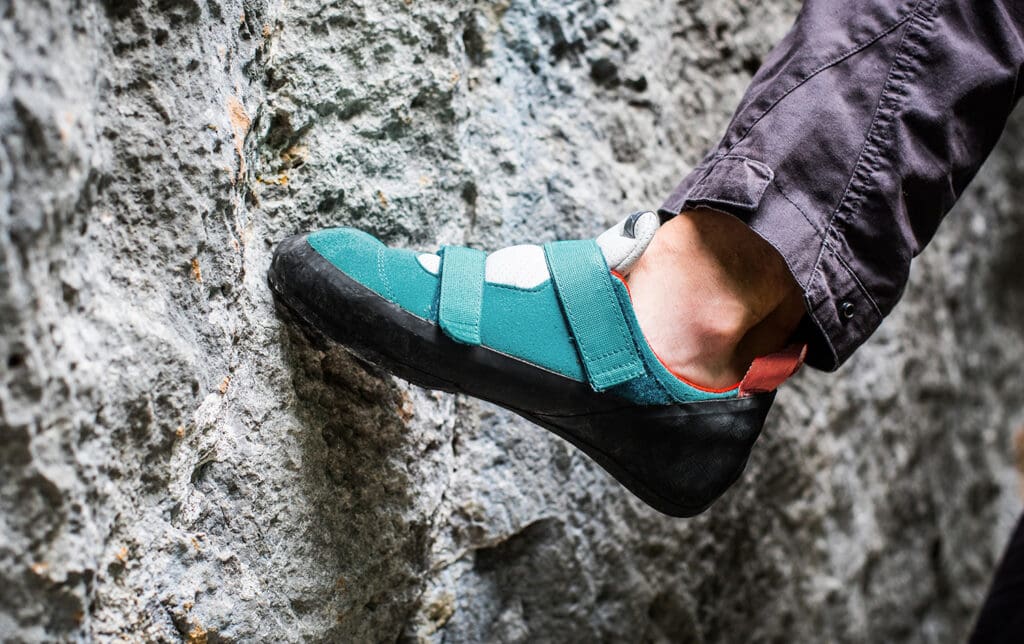
The upper is the fabric part of climbing shoes that connects to the rand and contains the closure. Uppers are generally in either leather, synthetic materials, or a combination. This shoe part is important to notice when choosing the correct size and fit for your feet.
Leather shoes have a significant amount of stretch to them. Lined leather will stretch about a half size or less once worn in, and unlined leather can stretch up to a full size. When choosing unlined shoes, you need to start with a size that gives you a really snug fit. Ensure your toes touch the end of the shoe, but your toe knuckles don’t bend. This will allow for the best fit even after they have fully stretched.
Synthetic shoes have minimal stretch. With minimal stretch, expect these shoes to fit about the same, even after some wear. It’s important to know that the upper material of your climbing shoes will significantly impact the size that you choose.
Rubber Outsole
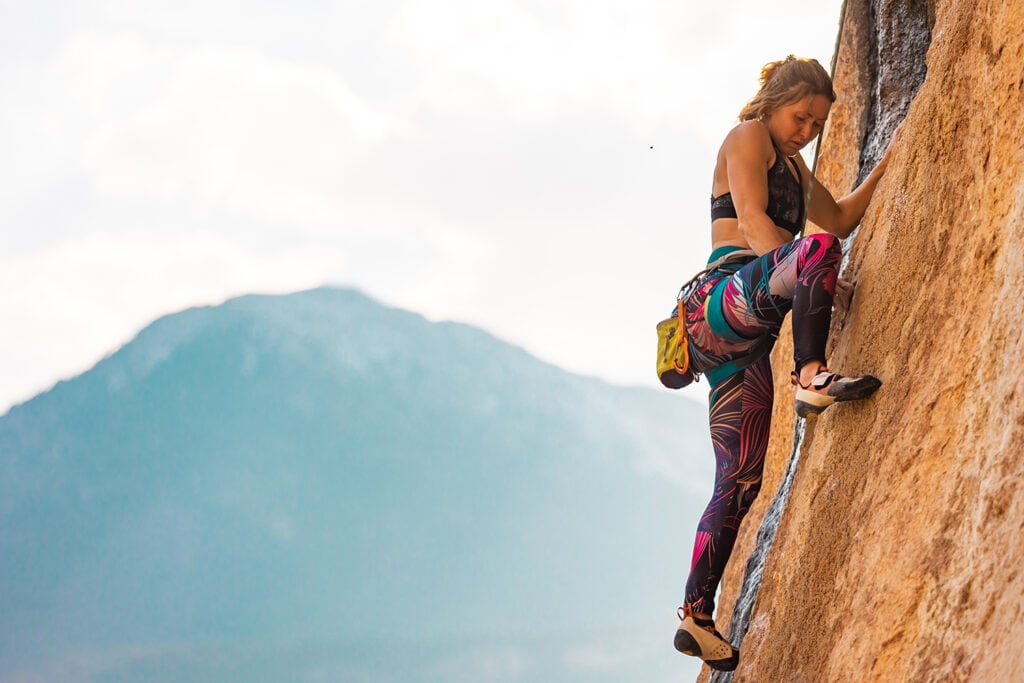
The rubber outsole of climbing shoes comes into direct contact with rock and other surfaces. This rubber is available in various thicknesses and types. Sticky rubber outsoles are popular because they deliver a better grip and are also ideal for smearing. Unfortunately, this type of rubber is less durable. Thicker, firmer rubber provides more support for your foot and is ideal for edging. The only downside to this type of rubber is that the thickness will affect your sensitivity to surfaces.
Rubber sole thickness ranges from 3 mm to 5.5 mm. A 3 to 4 mm outsole will provide more sensitivity while a thicker outsole at 4 to 5.5 mm thick, is more durable and provides extra support. A thicker outsole is perfect for beginner climbers.
Closure
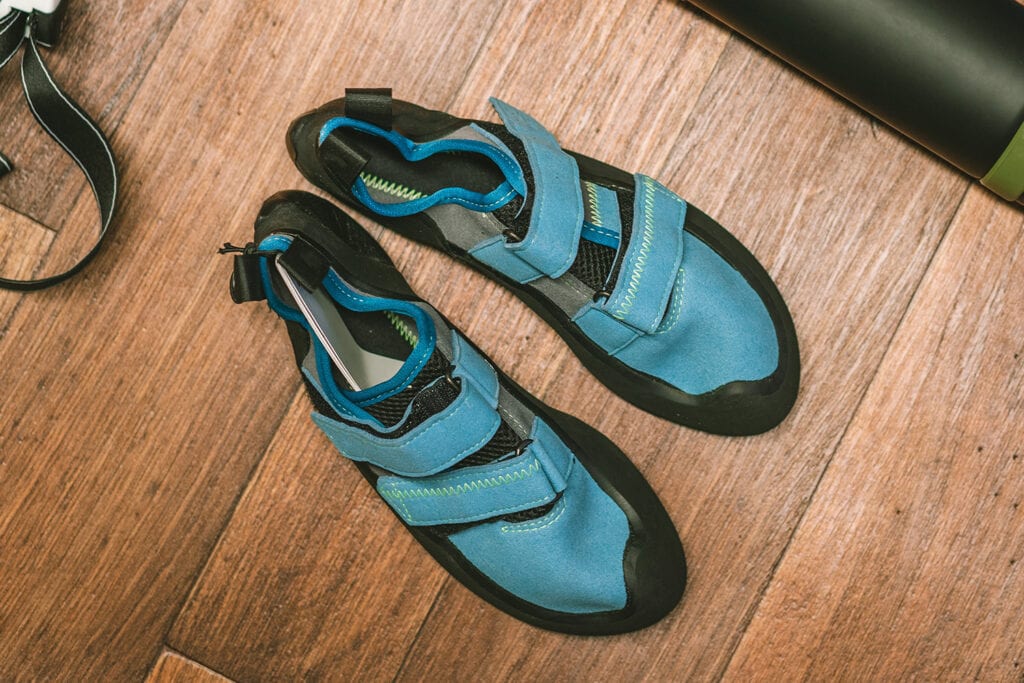
Climbing shoes use three basic closure types; lace-up, straps, and elastic. Lace-up shoes are a good choice for high adaptability. Laces allow you to tighten or loosen them with great accuracy and accommodate for temperature changes or swelling.
The straps of climbing shoes are generally using velcro. Although straps are less adjustable, this type of closure is great for bouldering and other situations where you often slip shoes on and off.
A slip-on shoe, also called a slipper, contains elastic closures. Slippers have a low profile and softer midsole, and are great for training and strengthening your feet. These soft shoes offer no adjustability so the size you choose must fit snugly. Slip-on shoes are a great choice for crack climbing, especially while working on very thin cracks.
Why It’s Important to Get the Right Fit
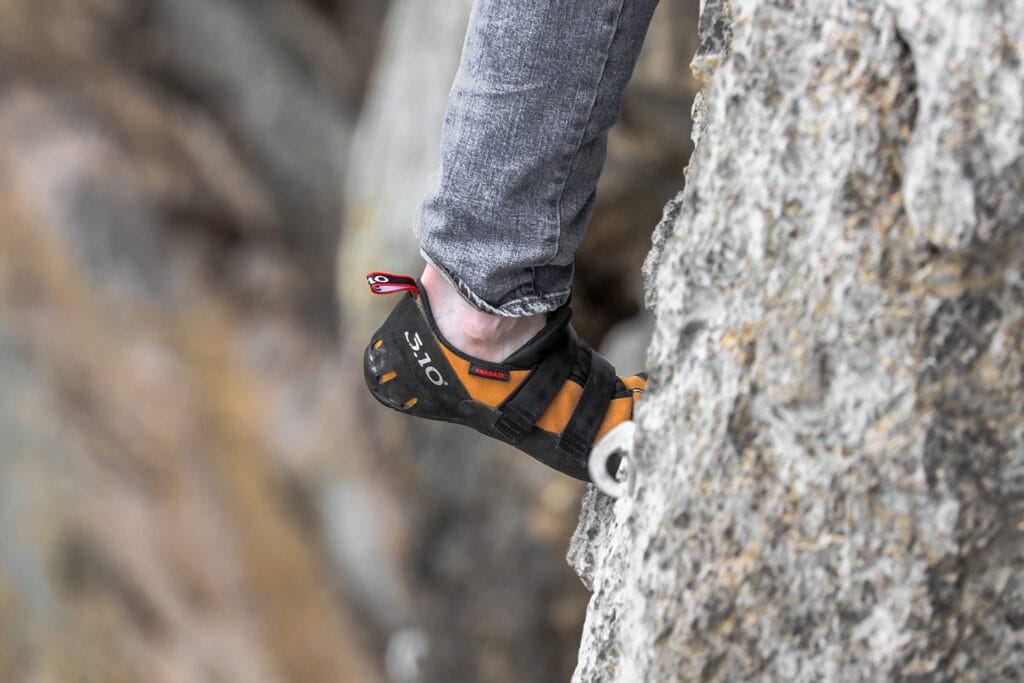
Different brands will not all fit your feet the same, so be sure to try on a variety before committing to a pair. So, how do you make sure that your climbing shoes fit?
Ideally, they should fit like a second skin. This means that they are comfortable, fit snug, and contain no hotspots or dead space while on your feet. Climbing shoes should fit well for performance, durability, and comfort relative to the type of climbing you partake in.
Comfort
Finding a comfortable shoe is important for many climbers. For a long day at the crag or climbing for multiple days at a time, finding comfort is necessary. Make sure to choose the right rock climbing shoes for your foot shape and climbing style. This will allow for continuous comfort all day.
If you’re focusing on comfort, flat shoes may be the option for you!.
Performance
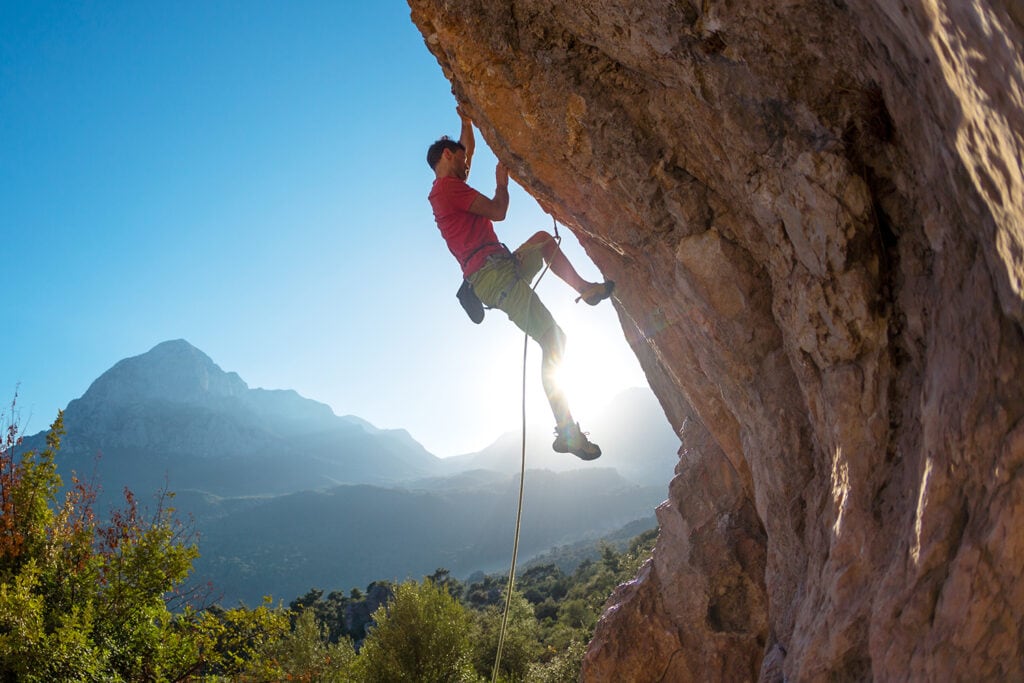
If your climbing shoes fit poorly, your performance will suffer. There’s no way of getting around it. Dead space, air pockets, and heel slipping are large problems and cause safety issues. Painfully tight climbing shoes make for an unpleasant climb.
If you’re focusing on bouldering or sport climbing, moderate or aggressive shoes will optimize your performance. The downturned shoes rely on tension from the slightly curled toes and only work with a good, tight fit.
It’s important to note that tight climbing shoes bring on better performance, as long as they aren’t too tight to negatively affect the circulation in your foot or big toe. When it comes to how your rock climbing shoes fit, keep in mind that your performance is at stake.
Durability
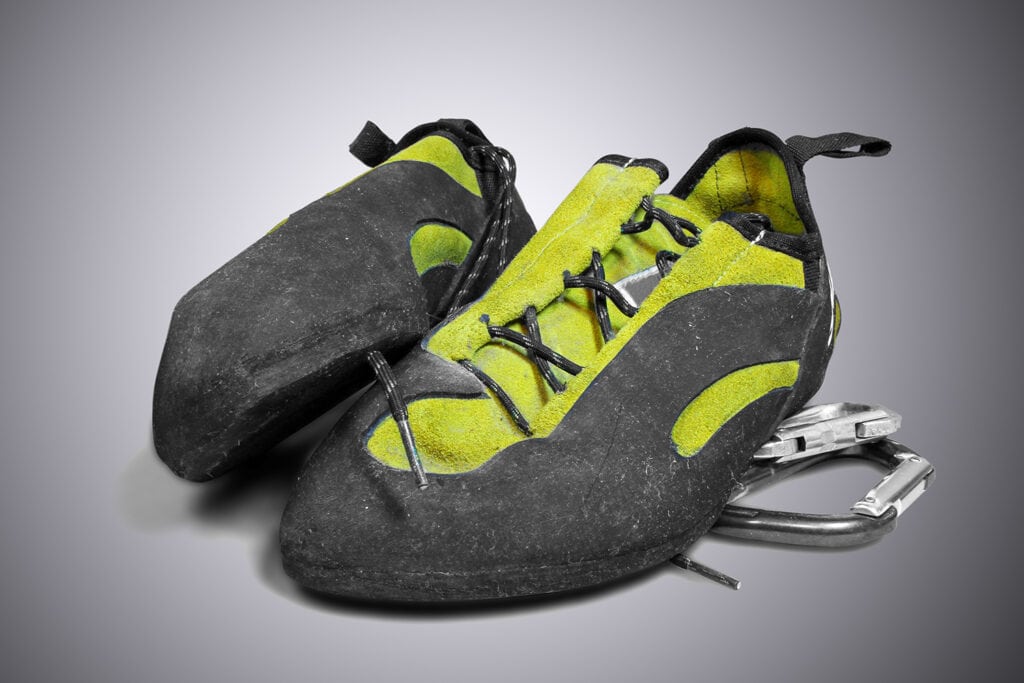
Climbing shoes last between 3 to 9 months, on average. This is determined by how often the shoes are used, the type of surfaces they have come into contact with, and the materials within the shoe’s design. For a more durable fit, it is advised to choose a thicker rubber outsole. This will increase the wear time between repairs or full replacements.
Things to Consider to Get the Right Fit
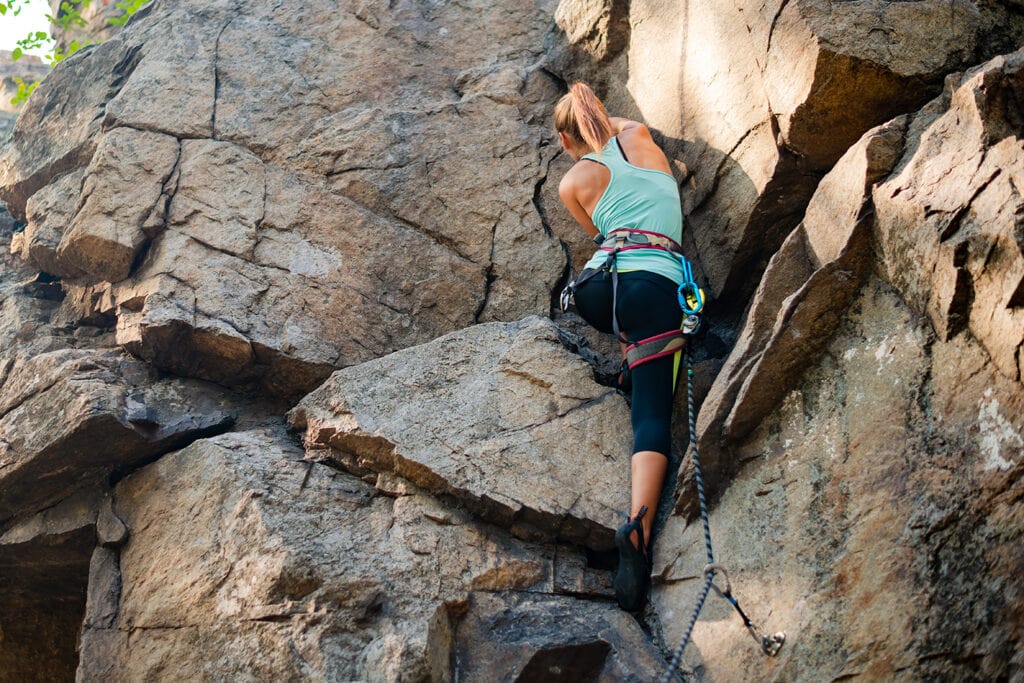
When fitting climbing shoes to your feet, getting the right fit can be tough, especially if you can’t climb in them before purchasing. Different foot shapes may or may not fit better in certain brands. It is best to try on a variety of brands and test them out if you can. Tighter shoes aren’t always better, but shoes that are too loose won’t perform as you expect them to do either.
Type of Shoe (e.g. Comfort vs Performance Fit)
Wearing climbing shoes for long periods of time is not always comfortable. But with the right fit, you can find the relative comfort that you’re looking for. A more flat shoe offers a relaxed fit and will be the most comfortable option for beginners.
A tighter shoe with a snug fit is the best pick whenever you’re spending a lot of time on overhanging rock, crack climbs, or advanced routes. These shoe types are more aggressive, and may not be as comfortable for long-term wear but are a good performance fit. It’s important to evaluate your priorities when choosing the right type of shoes for you.
Use (e.g. Trad vs. Sport)
Whether you’re spending all day at the crag or going for a few short climbs at the bouldering wall, the type of shoe you choose makes a difference. Choose climbing shoes that will be ideal for the type of activity that you’re doing.
How Tight Should Climbing Shoes Fit?
As we’ve seen, many factors will influence how your climbing shoes should fit, especially the type of shoes and climbing style. Overall, climbing shoes should be tight but not painful.
However, it can be difficult to evaluate correctly how tight the fit should be since climbing shoes can stretch over time. That’s why it’s important to research properly before buying to avoid surprises. Continue reading in the next section to discover all the tips to find the perfect fit for your climbing shoes.
Important Tips to Fit Climbing Shoes
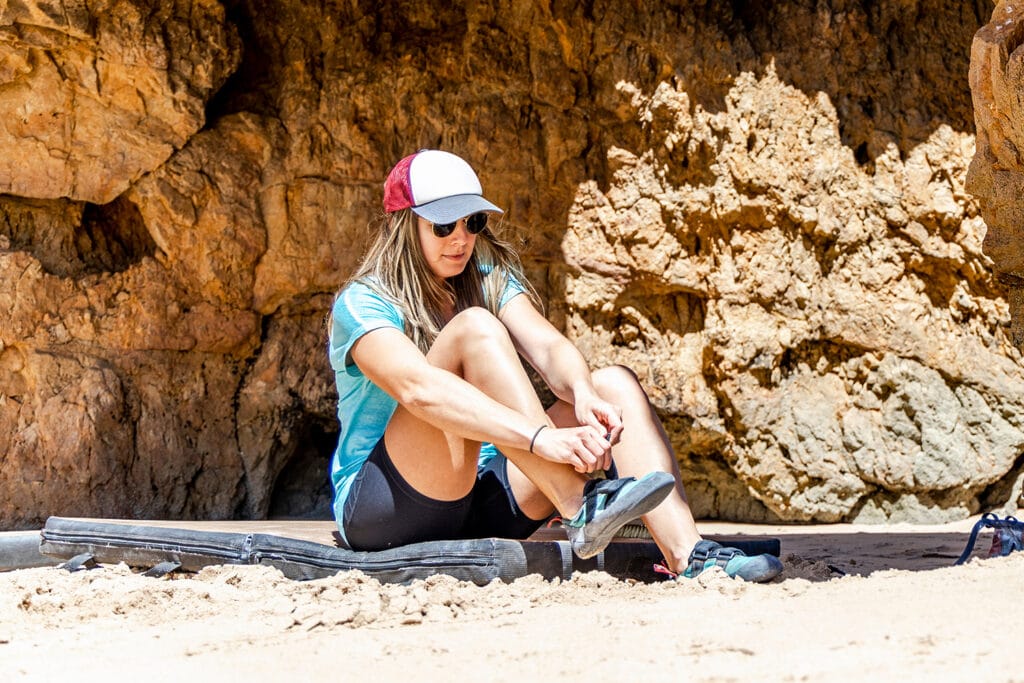
1. Research
Investigate ahead of time and know what type of shoe and fit you’re looking for. Beginner shoes are flat and more comfortable and are perfect for new climbers. Moderate or aggressive shoes are perfect for bouldering, sport climbing, and more experienced climbers.
2. Shop Later in the Day
The best time to shop for climbing shoes is in the afternoon or evening. Your feet naturally swell during the day, so it’s best to shop when your feet are at their biggest to get the sizing right. Go for a hike, walk, or climb before trying on in-store for a more accurate fit.
3. Get the Right Information on Sizing
Climbing shoes come in US, European, and United Kingdom sizes. Each sizing scale will fit differently. Be sure to check the sizing charts on each shoe. Some shoes will not match your regular street size. Note: Backcountry has a nice calculator that’s relatively accurate (it varies per model).
4. Pick a Model Suitable for Your Foot Shape and Volume
The shoe should fit your specific foot characteristics. The shape of your foot is highly individual but can be classified into five main categories: “Egyptian,” “Greek,” “Roman,” “Celtic,” and “Germanic.” Next, the volume of your foot will help you narrow down your climbing shoe selection based on how much space they offer, especially in the toe box and mid-foot. Most brands indicate for each model if it’s low, high or standard volume.
5. Try Both the Men’s and Women’s Models
Climbing shoes traditionally come in men’s and women’s versions. Women’s sizes have a narrower fit, are cut lower around the ankle, and have a smaller heel cup. Although there are men’s and women’s sizes, you don’t have to use one specific gender of the shoe. Just pick the one that fits best! Nowadays, many modern shoes are switching to unisex design with a Low Volume (LV) version.
6. Consider the Stretch
The climbing shoes you try in the shop will not be the same after a few sessions on the wall or at the crag. As a result, what was snug may become loose, while what was painful may become nicely snug. The only research is to research beforehand to determine how much the shoes will stretch. Leather shoes tend to stretch more than synthetic shoes, but it can vary from one model to another.
Check climbing forums/groups, and ask your friends or the vendor.
7. Try Them on Barefoot
Try them on in the store or at the gym/crag and make sure you’re barefoot. Your toes should lay flat and your toe knuckles shouldn’t be bunched up against the inside edge. Make sure the shoes fit snugly against your heel and that there’s no slipping or pinching on your Achilles tendon. If it’s painful, it means the fit is too tight.
Please note: If you’re new to the sport, start by choosing a flat shoe. New climbers aren’t familiar with aggressive shoes’ stiff, downturned shape and may initially choose the wrong size and fit.
FAQs

Yes, properly fitting climbing shoes should feel snug, slip on easily, and fit comfortably with minimal dead space. They should not be painful to wear. If your shoes feel extremely uncomfortable, please invest in different shoes.
This will depend on the type of shoe and the materials involved. Generally, you should choose a half to a full size smaller than the size of your street shoes. Sometimes you will, in fact, wear the same shoe size as other shoes you own.
When purchasing a new pair of climbing shoes, you will experience some tightness, discomfort, and foot pain during the break-in period. Climbing shoes are meant to fit like a second skin and can be painful at first. Take time to climb in them, and use one of the five tried and true methods to break in your new shoes.
How should climbing shoes fit? The right climbing shoes are the shoes that give you a perfectly snug fit. Knowing your foot shape and understanding all the variables involved in the shoe design of is the best knowledge to have when investing in this vital piece of climbing gear.
Are you ready to pick the perfect model? Check out our favorite climbing shoes for 2024.
